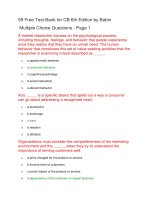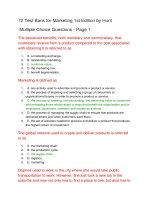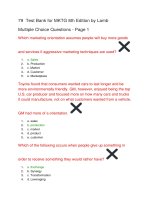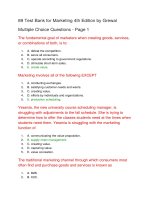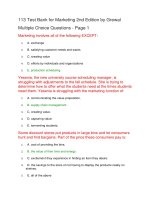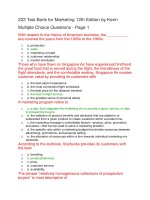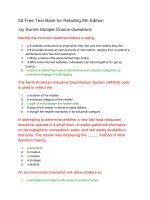Test bank for psychology 8th edition by gray
Bạn đang xem bản rút gọn của tài liệu. Xem và tải ngay bản đầy đủ của tài liệu tại đây (66.94 KB, 13 trang )
1. Behavior and mind comprise the:
A) science of psychology.
B) two entities of dualism.
C) unique human characteristics.
D) drives of humans.
2. Psychologists study ____ by observing ____.
A) behavior; the mind
B) the mind; behavior
C) culture; the mind
D) disorders; behavior
3. Wilhelm Wundt is the founder of:
A) the machine analogy.
B) functionalism.
C) dualism.
D) scientific psychology.
4. The pineal body:
A) is located in the left hemisphere of the brain.
B) is located in the right hemisphere of the brain.
C) was initially believed to house the soul.
D) was said to control human behavior within the brain.
5. Hobbes is to _____ as Descartes is to _______.
A) dualism; materialism
B) materialism; dualism
C) materialism; empiricism
D) empiricism; materialism
6. ______ proposed the philosophy of materialism.
A) Paul Broca
B) Ivan Pavlov
C) Reflexologists
D) Thomas Hobbes
7. Ivan Pavlov is most closely associated with:
A) reflexology.
B) materialism.
C) localization of function.
D) biology.
8. Materialism led to the school of thought in England known as:
A) empiricism.
B) dualism.
C) functionalism.
D) nativism.
9. Association by contiguity is the:
A) linking of two environmental events.
B) linking of events resulting from constant experience.
C) philosophical term referring to inherent knowledge.
D) distinction between a priori and a posteriori knowledge.
10. Brian's ability to learn a language at a young age is considered _____ knowledge; learning a second language in high school
is considered _____ knowledge.
A) internal; external
B) a priori; a posteriori
C) natural; secondary
D) a posteriori; a priori
11. Kant is associated with which movement in psychology?
A) nativism
B) materialism
C) empiricism
D) dualism
Page 1
Full file at />
12. In terms of modern levels of analysis, Darwin today would be considered a(n):
A) behavioral geneticist.
B) behavioral neuroscientist.
C) evolutionary psychologist.
D) learning psychologist.
13. Which level of analysis is associated with the brain as a cause of behaviors and mental processes?
A) neural
B) physiological
C) learning
D) genetic
14. If Dr. Romanfar is a cognitive psychologist, what would he focus on when working with clients?
A) The clients' beliefs and memories.
B) The physical state of the brain and neurons.
C) The clients' genetic makeup.
D) The clients' ability to learn new thought patterns.
15. Which statement regarding social psychology is FALSE? Social psychology
A) attempts to explain how an individual is influenced by perceived consequences.
B) emphasizes the presence of others as a driving force for behavior.
C) explains the thoughts and beliefs of outside perceptions and their effect on behavior.
D) focuses on an individual's behavioral history and how it fosters values.
16. The belief that certain parts of the brain serve specific functions is most closely associated with
A) reflexology.
B) materialism.
C) localization of function.
D) biology.
17. According to the definition offered in the textbook, psychology is the science of
A) the human mind.
B) human and animal behavior.
C) thinking, feeling, and motivation.
D) behavior and the mind.
18. Psychology is the science of behavior and the mind. Behavior refers to
A) the observable actions of a person or an animal.
B) an individual's sensations, perceptions, memories, thoughts, dreams, motives, emotional feelings, and other subjective
experiences.
C) the parts of the brain that serve specific functions in the production of mental experience.
D) adolescent brain function.
19. Professor Williams tells his class to close their eyes and think of their last vacation to the beach. He asks whether his students
find the memory of sand and the sound of the ocean to be pleasant or unpleasant. Professor Williams's focus on his students'
memories refers to which part of the individual?
A) the soul
B) the body
C) the spirit
D) the mind
20. If psychology can be defined as the science of behavior and the mind, why are the data in psychology always drawn from
behavior?
A) Behavior can be influenced by physiology but the mind cannot.
B) Behavior can be influenced by the environment but the mind cannot.
C) Behavior can be observed but the mind cannot.
D) Behavior can be influenced by science but the mind cannot.
21. Psychologists study the mind by observing behavior because
A) the mind is observable but cannot be explained.
B) psychologists are all behaviorists.
C) behavior can be observed but the mind cannot.
D) behavior is the result of the environment but the mind is not.
Page 2
Full file at />
22. _____ is considered to be the founder of scientific psychology, in part because he founded the first university-based
psychology laboratory.
A) René Descartes
B) Sigmund Freud
C) Ivan Pavlov
D) Wilhelm Wundt
23. Wilhelm Wundt is credited as the founder of scientific psychology because he
A) created the term "psychology."
B) was the first to conduct psychological research on reflexes.
C) published the first textbook that defined psychology as a science.
D) was the first theorist to consider the role of physiology in psychological processes.
24. If a person believes that a nontangible soul exists separately from the material body, then that person's beliefs identify with
the philosophical belief known as
A) reflexology.
B) nativism.
C) dualism.
D) materialism.
25. _____ is the philosophical theory that two distinct systems—the material body and the immaterial soul—are involved in the
control of behavior.
A) Dualism
B) Materialism
C) Empiricism
D) Nativism
26. According to the theory of dualism, behavior is controlled by the
A) mind and the brain.
B) heart and the will.
C) body and the soul.
D) brain and the muscles.
27. Which opinion demonstrates Descartes' philosophy of dualism?
A) The soul is responsible for an individual's consistent anger.
B) The body's lack of nutrition is responsible for an individual's consistent anger.
C) An individual's self-degrading thoughts are responsible for an individual's consistent anger.
D) Gloomy weather is responsible for an individual's consistent anger.
28. In his view of dualism, Descartes believed that any behavior common to both human beings and nonhuman animals must be
produced by the _____ and not the _____.
A) muscles; sense organs
B) body; soul
C) sense organs; muscles
D) soul; body
29. Descartes' version of dualism defines behavior as controlled by the soul and the body. His philosophy suggests that it is
possible to scientifically study behavior because
A) all human behaviors are produced by the soul.
B) all behaviors that are common to both humans and animals are produced by the body alone.
C) the soul does not exist outside the body.
D) the body controls physical movement and nonphysical thought.
30. Which of Descartes' beliefs helped pave the way to scientific psychology?
A) a nonphysical soul influences observable behavior
B) human thought could be studied scientifically
C) the body controls behavior mechanically
D) all of human behavior is purely reflexive, carried out by stimulus–response connections in the nervous system
31. Where did Descartes believe the soul was housed?
A) the pineal body
B) the prefrontal cortex
C) the hypothalamus
D) the heart
Page 3
Full file at />
32. What limitation makes Descartes' theory of dualism unacceptable to most contemporary psychologists?
A) The body is described as a physical machine that operates according to natural law.
B) Thought and thought-related phenomena are not accessible to scientific study.
C) Many actions are described in terms of reflexes.
D) The organ in which Descartes claimed the soul resides does not in fact exist.
33. Materialism is credited to which philosopher?
A) Thomas Hobbes
B) René Descartes
C) John Locke
D) Immanuel Kant
34. Andrew believes that a depressed client's self-degrading thoughts and self-injurious behaviors are the results of the
mechanical brain and body's control over the client's behavior. He only believes in matter and how it influences behavior.
Andrew's belief identifies with the early philosophy known as
A) materialism.
B) behaviorism.
C) dualism.
D) empiricism.
35. Thomas Hobbes's philosophy that all human behavior can be understood in terms of physical processes in the body,
especially the brain, is known as
A) empiricism.
B) nativism.
C) structuralism.
D) materialism.
36. Which of Hobbes's philosophical beliefs regarding materialism could be considered a precursor to a science of psychology?
A) The soul is a physical entity residing in the brain.
B) If physical effects can be caused only by matter and energy, then the nonphysical soul must be pure energy.
C) Thought is a result of physical processes in the brain.
D) The nonphysical soul's influence on the body is observable and can therefore be studied scientifically.
37. Hobbes's materialism proposed that the body
A) controls involuntary behavior while the soul controls voluntary behavior.
B) and the mechanistic brain control all voluntary and involuntary behavior.
C) and the soul interact to control both voluntary and involuntary behavior.
D) produces involuntary behavior when it conflicts with the soul.
38. When Bill asked his psychology professor to describe the free will of the soul, the professor responded, "There is no such
thing as a soul; all that exists is matter and energy." The professor's response suggests that he believes in the philosophy
known as
A) dualism.
B) nativism.
C) materialism.
D) reflexology.
39. Colin argues with a colleague that one part of the brain controls anxious thoughts while another part controls the way they
talk. What notion proposed in the 19th century supports Colin's argument?
A) localization of function
B) empiricism
C) reflexology
D) materialism
40. Early physiologists like Johannes Muller and Paul Broca conducted physiological research that led to the idea that people
experience vision when one part of the brain is active and hearing when another part is active. This research led to the
concept of _____, which refers to the idea that _____.
A) reflexology; every human action is initiated by stimuli in the environment
B) empiricism; all human knowledge and thought are derived from the patterning and association of sensory experiences
C) behaviorism; all behavior can be understood in terms of its relation to observable events in the environment rather than
to hypothetical events within the individual
D) localization of function; specific parts of the brain serve specific functions in the control of mental experience and
behavior
41. What physiological concept proposed that different sensory experiences excite different parts of the brain?
A) localization of function
B) natural selection
C) empiricism
D) levels of analysis
Page 4
Full file at />
42. What was the significance of Paul Broca discovering that the loss of the ability to speak is linked to damage in a specific area
of the brain?
A) It refuted the idea that mental processes interact to produce behavior.
B) It supported the idea that only humans can use language.
C) It suggested the idea that different parts of the brain serve different mental functions.
D) It refuted the concept of localization of function in the brain.
43. Broca's area in the brain's left hemisphere is an example of
A) localization of function.
B) mental retardation.
C) isolationism.
D) gerontology.
44. Charlotte falls from her bike and scrapes her knee after riding around a street corner too sharply. The next time she is riding
around a corner, she makes sure to slow down so that she will not fall and feel the pain of scraping her knee. What
philosophy does Charlotte demonstrate by learning from her initial sensory experience of falling and feeling pain?
A) nativism
B) empiricism
C) dualism
D) interactionism
45. Thomas Hobbes's ideas helped initiate the school of thought known as empiricism. Empiricism held as its central belief that
A) elementary ideas are innate to the human mind and do not need to be gained through experience.
B) human knowledge and thought derive ultimately from sensory experience.
C) observable actions of people and other animals should be studied, but sensory experiences should not be studied.
D) the relationship between human thoughts and experiences cannot be established.
46. Cassie is out with her friends at a bonfire. When Cassie moves closer to the fire, she experiences the sensation of heat. As a
result, Cassie begins to move toward the fire whenever she gets cold. This demonstrates how her sensory experience shaped
her behavior. Which philosophy would explain Cassie's behavior?
A) nativism
B) dualism
C) materialism
D) empiricism
47. Because Jordan often drinks coffee while eating bagels and reading the newspaper, the thought of one of these things also
makes Jordan think about the others. Aristotle would explain this phenomenon in terms of the
A) concept of localization of function.
B) law of association by contiguity.
C) theory of reflexology.
D) law of association by similarity.
48. Once when Josh had stomach flu, his mom used a strong floral fragrance when cleaning the living room. Now whenever he
smells the floral fragrance, he associates it with how sick he felt when he had the stomach flu. Which concept applies to
Josh's situation?
A) theory of reflexology
B) localization of function
C) law of association by contiguity
D) law of association by similarity
49. What psychological school of thought claims that all knowledge is based upon sensory experience?
A) empiricism
B) nativism
C) reflexology
D) neurology
50. According to empiricists, the _____ means that two events experienced together will be linked in the person's mind so that
the thought of one event will, in the future, tend to elicit the thought of the other.
A) theory of a priori knowledge
B) law of association by similarity
C) theory of topographical organization
D) law of association by contiguity
51. Which statement correctly represents the influence of empiricist philosophy on psychology?
A) Contemporary psychologists believe that some knowledge is inborn.
B) Empiricism inspired Ivan Pavlov's work toward the development of cognitive psychology.
C) Most psychologists are interested in the effects of experiences on one's thoughts, feelings, and behavior.
D) Empiricism influenced early psychologists' beliefs but has no real application in the field today.
Page 5
Full file at />
52. A young child falls into the deep end of a pool. The child surfaces and swims to the edge of the pool without having prior
swimming experience. This inborn behavior demonstrates which philosophy?
A) materialism
B) empiricism
C) nativism
D) dualism
53. Nativism is
A) the study of organisms in their natural environment.
B) the idea of being closely tied with one's culture.
C) the idea that knowledge comes from one's sensory experiences.
D) the idea that some knowledge is inborn in the mind and does not have to be learned by experience.
54. The view that elementary ideas are innate to the human mind and are not gained through experience is known as
A) empiricism.
B) dualism.
C) nativism.
D) materialism.
55. Nativism may be thought of as the opposite of
A) empiricism.
B) cognitive psychology.
C) physiological psychology.
D) dualism.
56. Immanuel Kant distinguished between _____ knowledge, which is built into the human brain and does not have to be learned,
and _____ knowledge, which is gained from experience in the environment.
A) a priori; a posteriori
B) nativist; empiricist
C) empiricist; nativist
D) a posteriori; a priori
57. Selena's ability to hold herself upright demonstrates _____ knowledge, while her ability to do a variety of yoga poses
demonstrates _____ knowledge.
A) nativist; semantic
B) a posteriori; a priori
C) a priori; nativist
D) a priori; a posteriori
58. After watching his infant son consistently reach for the largest of the three piles of marbles, Tyler begins to think that babies
may possess an inborn quantitative understanding. His belief is most consistent with the philosophical view known as
A) empiricism.
B) dualism.
C) nativism.
D) reflexology.
59. The idea that an inanimate object cannot learn because it does not possess any innate knowledge demonstrates which theory?
A) nativism
B) empiricism
C) materialism
D) behaviorism
60. Which type of knowledge did Kant say is built into the human brain and does not have to be learned?
A) environmental knowledge
B) a posteriori knowledge
C) semantic knowledge
D) a priori knowledge
61. Who was the scientist who wrote On the Origin of Species and proposed that natural selection leads to the evolution of
behavioral tendencies that promote survival and reproduction?
A) Wilhelm Wundt
B) Thomas Hobbes
C) Charles Darwin
D) René Descartes
Page 6
Full file at />
62. One of Darwin's key ideas is that, because of natural selection, animals have an inborn tendency to behave in ways that help
them to
A) use the least amount of energy.
B) select from various natural alternatives.
C) learn from their parents.
D) survive and reproduce.
63. Charles Darwin's study of functions of behavior differed from others because Darwin studied
A) the neural mechanisms of behavioral functions.
B) ways an organism's behavior helps it to survive and reproduce.
C) the soul and its influence on behavior.
D) the influence of behavior on the mind.
64. Darwin's concept of natural selection is most important for psychologists interested in the _____ of behavior.
A) functions
B) structures
C) limitations
D) variations
65. How did the contributions of Charles Darwin help make the world ripe for psychology?
A) He advanced the idea that specific parts of the brain serve specific functions in the production of mental experience and
behavior.
B) He helped convince people that humans are part of the natural world and can be analyzed in the same way as nonhuman
species.
C) He was the first to conceptualize the mechanical control of movement as reflexes, or involuntary responses to stimuli.
D) He was the first to challenge the church's view that the human soul could not be studied scientifically.
66. If Mariah is constantly lying about how much fun she is having in comments on social media and her mom says it is because
her friends always do the same thing, what level of analysis is she using?
A) social
B) genetic
C) cognitive
D) evolutionary
67. The phrase "level of analysis" may include all levels EXCEPT the _____ level.
A) social
B) evolutionary
C) tolerance
D) developmental
68. According to the book, "level of analysis" refers to
A) the number of mental constructs at a given moment in time.
B) the type of causal process that is referred to in explaining some phenomenon.
C) the process by which a psychologist observes a given behavior.
D) the rate at which a PET scan analyses brain waves.
69. Dr. Nguyen is interested in researching the role of the nervous system in a person's experience of sexual jealousy. What type
of researcher is Dr. Nguyen?
A) behavioral neuroscientist
B) behavioral geneticist
C) evolutionary psychologist
D) cognitive psychologist
70. Researchers who focus on individual neurons or small groups of neurons to determine how their characteristics contribute to
particular psychological capacities are
A) behavioral neuroscientists.
B) evolutionary psychologists.
C) cognitive scientists.
D) developmental psychologists.
71. Which method would a behavioral neuroscientist most likely utilize to study jealousy?
A) putting two rats in a maze and only allowing one rat to receive food while the other rat watches
B) modifying genes in order to observe the effect on jealousy
C) defining the forms and consequences of jealousy in order to identify its benefits for reproduction
D) mapping specific brain areas in order to observe which of these areas become more active during a jealous state
Page 7
Full file at />
72. Which approach would a behavioral geneticist most likely take in order to understand the factors involved in sexual jealousy?
A) Examine people who have suffered damage to brain areas that may cause a deficit in the experience of jealousy.
B) Investigate how jealousy may promote long-term mating bonds and reproduction.
C) Identify how reinforced jealous reactions may increase in frequency and how ineffective reactions may decrease.
D) Measure the degree of jealousy displayed in identical twins as compared to nonidentical twins.
73. Who would use Darwin's theories most directly?
A) evolutionary psychologists
B) neural psychologists
C) social psychologists
D) cognitive psychologists
74. Which area of psychology would best explain behavior in terms of past experiences with the environment?
A) cognitive
B) learning
C) social
D) evolutionary
75. In his research, Dr. Madden attempts to relate learning experiences directly to behavioral changes and is relatively
unconcerned with the mental processes. Dr. Madden is most likely a(n) _____ psychologist.
A) cognitive
B) learning
C) developmental
D) evolutionary
76. To a learning psychologist, experience in the environment leads to a change in _____, whereas to a cognitive psychologist,
experience in the environment leads to a change in _____.
A) knowledge or beliefs; behavior
B) reproductive benefits; brain regions that process the experience
C) behavior; knowledge or beliefs
D) brain processes; survival or reproductive benefits
77. Suppose Dr. Schlesinger is investigating food aversions that some women develop while pregnant. She is particularly
interested in the aversion to green vegetables and has hypothesized that this aversion has survival benefits, given that some
plants can contain toxins harmful to developing fetuses. These research interests suggest that Dr. Schlesinger is most likely
a(n)
A) developmental psychologist.
B) behavioral neuroscientist.
C) evolutionary psychologist.
D) learning psychologist.
78. Jane is a psychology student and wants to focus her study on the human memory. Studying human memory also involves
studying human beliefs and thoughts. What is Jane ultimately studying?
A) level of analysis
B) behavior
C) cognition
D) reflexology
79. The study of information that is stored and activated by the brain, such as beliefs, thoughts, or forms of memories, is part of
which branch of psychology?
A) behavioral
B) cognitive
C) physiological
D) epigenetic
80. A psychologist is researching effective learning strategies for acquiring a second language. This type of research is
A) cognitive.
B) social.
C) developmental.
D) neurological.
81. Cognitive psychology is BEST characterized as the study of the
A) physiological mechanisms in the brain that mediate behavior.
B) various forms of mental information that guide behavior and experience.
C) various mental and/or emotional disorders that trouble people.
D) changes in behavior that directly relate to changes in the environment.
Page 8
Full file at />
82. Annie uses computer models to study how people acquire, organize, remember, and use knowledge about video games to
guide their behavior when playing. Annie is probably a _____ psychologist.
A) cognitive
B) cultural
C) learning
D) social
83. Logan is interested in how the processing and organization of memories involving people of other races might contribute to
prejudiced beliefs and behaviors. She is looking for a _____ explanation of prejudice.
A) cognitive
B) cultural
C) social
D) learning
84. Which type of psychologist would be interested in the number of teenagers who started smoking cigarettes due to their group
of friends who are also smokers?
A) social
B) behavioral
C) evolutionary
D) cultural
85. A psychologist attempts to understand the conditions in which people are more likely to go along with the decision of the
group even when they know the group is wrong. Understanding the influence that other people have on an individual's
behavior is most consistent with a _____ level of analysis.
A) cultural
B) cognitive
C) social
D) learning
86. Social psychology is the study of how the thoughts, feelings, and behaviors of
A) individuals are influenced by others.
B) groups are influenced by their cultural heritage.
C) individuals are influenced by inborn characteristics.
D) individuals are influenced by mental disorders.
87. Carlos is conducting a laboratory study of obedience. He is interested in how the proximity of the authority figure contributes
to the level of obedience. Carlos's field is most likely _____ psychology.
A) social
B) cultural
C) cognitive
D) learning
88. Lin is conducting a series of experiments on prejudice. Her interest in the processes through which people are influenced by
other people's beliefs is consistent with _____ psychology.
A) developmental
B) clinical
C) cognitive
D) social
89. The branch of psychology that emphasizes how the general psychological processes of an individual are influenced by other
people at a given point in time is called _____ psychology.
A) cultural
B) social
C) developmental
D) clinical
90. Sophie studies the differences between societies that have an individualistic view versus a collectivistic view. She most likely
would describe herself as a _____ psychologist.
A) cognitive
B) social
C) developmental
D) cultural
91. Hassam traveled to three different countries to study the differences among people and the ways by which people's thoughts,
feelings, and behavior are influenced by their societies. Hassam is probably interested in _____ psychology.
A) cultural
B) cognitive
C) evolutionary
D) social
Page 9
Full file at />
92. A cultural psychologist would be most interested in studying
A) discipline styles among parents from three countries.
B) aggressive drives contained in the minds of prisoners.
C) teachers' ability to encourage students' creativity in a kindergarten classroom.
D) reasons people go to art museums.
93. A cultural psychologist would most likely investigate jealousy by
A) emphasizing the immediate social influences that act on individuals and affect their beliefs about jealousy.
B) examining significant differences in romantic and sexual behavior across different countries.
C) describing age-related changes in jealousy that correspond with age-related changes in social relationships.
D) focusing on how people's knowledge or beliefs about jealousy cause them to engage in specific behaviors with their
romantic partner.
94. Which explanations for behavior describe the typical age differences that occur in how people act and think?
A) developmental explanations
B) social explanations
C) cultural explanations
D) evolutionary explanations
95. Mohammed is interested in comparing young children, older children, and adolescents in terms of their moral reasoning level.
Given his interest in typical age-related changes in reasoning, he is most likely a _____ psychologist.
A) social
B) learning
C) cultural
D) developmental
96. Tanesha has taught dance classes to children of various ages. She believes she is good at determining how to best teach a
child to dance based on the child's physical and emotional maturity. Based only on this information, what psychological
specialty may best suit Tanesha?
A) clairvoyant psychology
B) cognitive psychology
C) evolutionary psychology
D) developmental psychology
97. Certain specialties within psychology, such as sensory psychology, perceptual psychology, and the psychology of motivation,
do not correspond to the different levels of analysis discussed in the textbook because they
A) are such small and highly specialized areas of study that they do not employ any of these levels of analysis.
B) are more appropriately classified under the spectrum of disciplines known as the natural sciences.
C) might use any or all of psychology's levels of analysis to understand the specific topics they study.
D) were important areas of study when psychology first emerged as a discipline but are not actively pursued in
contemporary psychology.
98. Psychology as an academic discipline MOST comfortably fits
A) among the social sciences.
B) as a field that bridges social sciences and natural sciences.
C) among the humanities.
D) as a field that bridges social sciences, natural sciences, and the humanities.
99. The belief that all behaviors are a result of involuntary reactions to stimuli in our environment is
A) dualism.
B) nativism.
C) materialism.
D) reflexology.
100. Reflexology was born out of the understanding of how _____ work together to create reflexive actions.
A) the central nervous system and peripheral nerves
B) the peripheral nervous system and pineal gland
C) localized brain areas
D) body and soul
101. Carlos tells everyone he can't help his fidgeting because it is something he cannot control, he was born that way. What level
of analysis is he using?
A) social
B) genetic
C) cognitive
D) evolutionary
Page 10
Full file at />
102. Which is a specialty better defined by the topic it studies than by the level of analysis?
A) behavioral genetics
B) perceptual psychology
C) social psychology
D) behavioral neuroscience
103. The two major specialties that are devoted to the task of understanding individual differences among people are
A) behavioral genetics and personality psychology.
B) perceptual psychology and abnormal psychology.
C) personality psychology and abnormal psychology.
D) social psychology and personality psychology.
104. Which is NOT one of the three main divisions of academic studies demonstrating that psychology is a hub science?
A) natural sciences
B) social sciences
C) humanities
D) mathematics
105. What philosophical developments helped to create an intellectual atmosphere in which a scientific psychology could emerge?
106. Discuss Darwin's basic ideas and their influence on psychology.
107. Choose three of the levels of analysis described in Chapter 1 of the text and compare them in terms of how they approach the
subject matter of psychology.
108. Discuss the similarities and differences between learning psychology and cognitive psychology OR social psychology and
cultural psychology.
109. Choose three of the levels of analysis described in Chapter 1 of the text and compare them in terms of how they might
approach the topic of grief.
110. Use the three fundamental ideas of psychology to explain why psychology is a science.
Page 11
Full file at />
Answer Key
1.
2.
3.
4.
5.
6.
7.
8.
9.
10.
11.
12.
13.
14.
15.
16.
17.
18.
19.
20.
21.
22.
23.
24.
25.
26.
27.
28.
29.
30.
31.
32.
33.
34.
35.
36.
37.
38.
39.
40.
41.
42.
43.
44.
45.
46.
47.
48.
49.
50.
51.
52.
53.
54.
55.
56.
57.
58.
59.
60.
61.
62.
63.
64.
65.
66.
67.
68.
69.
70.
71.
72.
73.
74.
75.
76.
A
B
D
C
B
D
A
A
A
B
A
C
A
A
D
C
D
A
D
C
C
D
C
C
A
C
A
B
B
C
A
B
A
A
D
C
B
C
A
D
A
C
A
B
B
D
B
C
A
D
C
C
D
C
A
A
D
C
A
D
C
D
B
A
B
A
C
B
A
A
D
D
A
B
B
C
Test Bank for Psychology 8th Edition by Gray
Full file at />
Page 12
Full file at />
77.
78.
79.
80.
81.
82.
83.
84.
85.
86.
87.
88.
89.
90.
91.
92.
93.
94.
95.
96.
97.
98.
99.
100.
101.
102.
103.
104.
105.
106.
107.
108.
109.
110.
C
C
B
A
B
A
A
A
C
A
A
D
B
D
A
A
B
A
D
D
C
D
D
A
B
B
C
D
Test Bank for Psychology 8th Edition by Gray
Full file at />
Page 13
Full file at />
